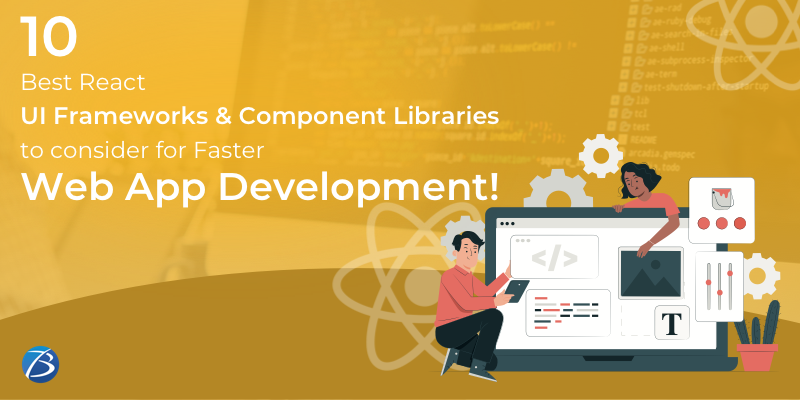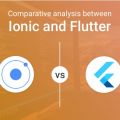10 Best React UI Frameworks & Component Libraries to consider for Faster Web App Development

React.js, popularly known as React, is an open-source JavaScript library that facilitates the creation of user-centric web apps with an unmatched user interface. React is a preferred choice for web app development owing to advantages like code reusability, effortless scripting, SEO-friendliness, easy learning curve, cost-efficiency, and high speed due to the usage of a virtual DOM.
For developing React web apps faster and more conveniently, developers and designers leverage the components offered by React frameworks and component libraries. React components are independent bits of code that are reusable. These components play a crucial role in improving the speed, efficiency, and productivity of web app development projects.
This post enlists the best React libraries and React frameworks of 2022 that ensure faster web app development.
Significant React UI Frameworks & React Component Libraries
1. React Bootstrap
This React UI framework is one of the best options for a front-end web development. React-Bootstrap has replaced JavaScript-Bootstrap. Here, the native Bootstrap components are offered as pure React components. The creators of this library have not made use of JavaScript-based sources and plugins from the CDN. Instead, all the components have been re-built in React without using unnecessary dependencies like iQuery.
This library offers a wide variety of components that optimize accessibility. Using React Bootstrap, projects can be designed on the back end and prototyped on the front end. Hence, it is immensely useful in web development projects where teams are working on various aspects of an app. Moreover, it has well-created documentation along with code samples and enjoys 19.8k GitHub stars.
2. Semantic UI React
This is an open-source React CSS framework with 12.4 k GitHub stars comprising wholly featured React UI libraries. Semantic UI React is the official React integration into the originally existing Semantic UI framework. This version of the Semantic UI is jQuery-free; the jQuery features have been re-implemented using React.
Semantic UI React offers a plethora of pre-built components that help React developers create semantically friendly codes. Its declarative API facilitates building robust features and validating props. Thanks to its powerful augmentation, props and component features can be built without having to include additional nested components. This leads to the creation of unique component features. Besides, there are Shorthand props that help in generating markups. The sub-components available, help in accessing and editing markups; this provides flexibility while customizing components. The functionality, auto-controlled state, plays a crucial role in extending the concept of React’s controlled and uncontrolled components. Here, the components self-manage themselves without the need for wiring. This makes it easier for developers to manage props with the help of React UI libraries.
3. Ant Design
Ant Design is one of the most suitable React UI frameworks that facilitates the development of enterprise-grade web apps. It’s written in TypeScript and contains predictable static types. This library offers quality components and demos for designing high-end and interactive user interfaces. One of its unique features includes internationalization support for numerous languages. This popular library boasts 70k GitHub stars and has been utilized by renowned brands like Tencent, Baidu, and Alibaba.
Ant Design comes with several amazing components including dropdown menus, grids, icons, buttons, breadcrumb, and pagination. Moreover, you will be able to customize the components as per your design specification requirements.
4. MUI (Previously known as Material UI)
This is one of the most sought-after open-sourced React frameworks that contributes a great deal to enhance the speed of the web development process. MUI, architected in JavaScript (63.9%) and TypeScript (36.1%), is not merely a component library; it offers a whole design system. It comes with a host of foundational as well as advanced pre-built components and templates for navigation, forms, layouts, data display, and many more. Moreover, each component fulfills the present accessibility standards and can be customized as per the user’s requirement. Therefore, users need not waste time reinventing the wheel. Furthermore, it offers cross-browser compatibility; it can be used along with other frameworks like Angular & Vue.js for building that perfect web solution.
MUI provides multiple top-grade components for free usage. However, some components like the Date Range Picker and Data Grid, have been locked for free users. Those features can be accessed by MUI X Pro package users and offer advanced components and themes that allow you to create high-end digital experiences.
This powerful framework is maintained by a huge and vibrant community comprising indispensable contributors. There exists a comprehensive documentation and hence, developers enjoy an easy learning curve.
MUI boasts of 69.2k GitHub stars and 22.7k forks. It has been utilized for 745,000 + projects.
5. Chakra UI
This component library is simple and accessible; it offers the fundamental building blocks required for React app development. It comes with themes, 49 components like icons, inputs, tooltips, accordions, etc., and some handy custom hooks. It also offers various colors that can be used to change the brightness & darkness level as per the UI. These components adhere to the WAI-ARIA standards, are highly reusable, and can be easily customized. The modularity of the components enables developers to create efficient and clean codes. Chakra UI also has a dynamic community that extends a helping hand in case of any blocking issue.
6. Fluent UI
Fluent UI contains a collection of UX frameworks that helps in crafting alluring cross-platform web applications that share the design, code, and interaction behavior.
This open-source Microsoft-developed design system offers designers as well as developers outstanding web components utilities, and React components needed for creating an engaging UX. Fluent UI offers extensible JavaScript solutions for component state, accessibility, and styling. It has a simple API based on natural language and loads of robust features including internationalization and performance. The pre-built components offered by this library can be employed for designing major chunks of the web app.
It has 12K GitHub stars and comprehensive documentation. It has been employed for Microsoft sites like One Note, Office 365, DevOps, Azure, etc.
7. Grommet
This React framework, created by HPE, offers a neat package of over sixty components that provide modularity, accessibility, responsiveness, and theming capabilities. Additionally, you get Figma, AdobeXd files, Sketch, and over 600 SVG icons.
This lightweight tool offers color controls, layouts, templates, input visualization, etc. It enables one to create bold and captivating website designs that are unique. Grommet facilitates the development of mobile-friendly apps. Grommet enjoys 7.4K stars on GitHub and has been leveraged by several biggies including IBM, Uber, Netflix, Boeing, and Samsung.
8. Blueprint UI
This React component framework is a handy tool for developing complex and data-intensive UIs of web apps and desktops. It offers 40+ new-era components for building desktop apps. Blueprint UI is built using TypeScript, JavaScript, SCSS, and unspecified code. You can access the light and dark themes as per your need. The components include Table packages, Datetime icons, etc. With this library, you can customize color themes, classes, and typography, to tailor a personalized design. This library is the most suitable pick for architecting a data-dense desktop app employing pre-built components. The library has in-depth documentation as well.
9. Shards React
This open-source new-age React framework offers numerous options to web development teams for building web portals, precise dashboards, and mobile apps that cater to diverse industrial domains. Shards provide a wide range of components including custom React components like toggle inputs and sliders. Its basic library is free; the paid version (pro kit) offers extra components, blocks, and templates. Also, the pro version offers 15 pre-built pages that help one to get started.
This component library uses React Popper (positioning engine), React Datepicker, noUISlider; and supports Fontawesome and Material icons. The SCSS is employed for styling, elevating the developer experience.
Shards offers web development professionals the ideal blend of customization options. Moreover, it allows one to download source files so that modifications can be made at the code level as well. Shards functions speedily as well as efficiently on various platforms because of its optimized code.
10. React 360
Today, augmented reality and virtual reality are some of the most disruptive technologies that are leveraged by several industry verticals, particularly the eCommerce sector. Usually, a combination of AI and VR is employed to provide consumers with a virtual reality experience for trying out a product. This trend is gaining traction in other industries as well.
Have you ever imagined that such an AR/VR experience can be created with React? With the introduction of React 360, you can integrate AI and VR experiences in React apps as well. Using this library, React developers can create VR and 3D user interfaces that function across mobile/web apps, desktops, and VR devices. And, the best part is developers can create such immersive user experiences using standard React components and tools. React 360 allows you to build 2D interfaces embedded within 3D spaces and handle immersive experiences in a better way. The architecture of this library is meant to optimize the app’s performance as it reduces garbage collection and improves the frame rate.
Bottomline:
The aforementioned React frameworks and component libraries are the fastest-evolving libraries of modern times. These useful tools will enhance the productivity and convenience quotient of your React app development project. However, if you are a start-up developing an enterprise-level application, I would recommend you seek technical assistance from an experienced React Native app development company.
Other articles and publications:
- +1 (469) 277-0804
- 8305 Tripoli Trl, Frisco, TX 75034, United States
- www.biz4solutions.com/






